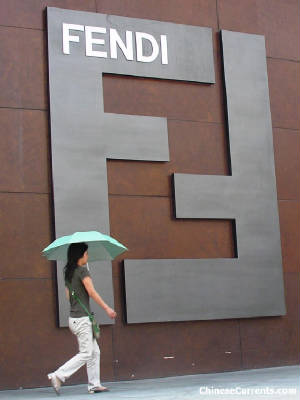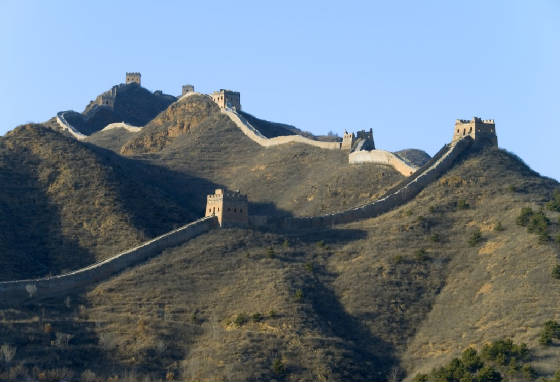|
Storming the Great Wall

|
| The double F ("Fun Furs"): "I never dreamt that one day..." |
After twenty minutes, the train slowed down as it entered Shanhaiguan station. Shanhaiguan is dominated by
an impressive mountain range, the Yan Shan, which extends all the way to Beijing after emerging from the sea here. This
was a Chinese border town until the day in 1644 when Wu Sangui, a general in the Ming army, opened the gates of the First
Pass Under Heaven to allow the Manchu army to march through. Beijing, the seat of the corrupt and dysfunctional
Ming dynasty was but a few days march away on flat ground “this side” of the First Pass.
Shortly
after leaving Shanhaiguan station, the “border” between civilisation and barbarianism – as defined by the
governments of the Ming dynasty – came into view. The Great Wall rises almost out of the sea
at Shanhaiguan, heads north and then west towards Beijing; snakes its way across the ridges and edges of numerous mountain
ranges before it at last, as if out of breath, crumbles into a pile of rubble near Jiayuguan Pass in Gansu Province, some
6,700km from here.
Since the first brick was laid two and a half thousand years ago, The Great Wall has seen innumerable skirmishes, attacks,
and counter-offensives. These days there is a PR battle raging around its ramparts. On one
side are the protectionists, who believe that it should be a preserved as a sacred monument and that people should have access
to only strictly limited and tightly-controlled areas of it, where they should go to appreciate the national
treasure. On the other side of the battle line are the people
who just want to go out there and enjoy it. Enjoyment comes in many forms though. Some want the
freedom to hike along its entire length; some want to go there for a special moment with their lover; others want to dance
and listen to music; while still others want to crank up the enjoyment levels a few notches beyond that.
Quentin Tarantino is a big fan of The Great Wall.
When asked during an interview with Playboy magazine
how he managed to entertain himself during the four months he was in China shooting some of the scenes for his Kill Bill film project, he gushed: “The first time I went to the Great Wall of China it was like an all-night rave. They had rock bands, fireworks. We were smoking pot and doing E. It was
great. Me and a bunch of the crew partied like rock stars all night. It’s
a great way to see the wall for the first time.” Indeed, whatever the
demand may be, these days in China, supply is quick to match it. And, sure enough, some local-government
offices have been cashing in on the money-making potential of “their” designated section of The Wall. The admin office responsible for the Juyongguan section (to the north of Beijing), for instance, decided to build
a “Great Wall of Love” at the foot of the real Wall, where love-struck couples could, for a hefty fee, carve their
pledges of eternal devotion into “Great Wall stones.” Not real ones, of course, but even
so the China Daily was so incensed by this blasphemous act (reportedly perpetrated by two couples on Valentine’s Day)
that it published an article titled “Great Wall demands respect not pricey love oath,” which was brimming with
indignation: They even went to the trouble of commissioning a satirical cartoon to underline their
displeasure. The sketch depicts a “love brick” vendor, in a booth on the top of a Great
Wall, shouting out, “stones for sale at 999 yuan each,” (about £65) to bemused Ming dynasty soldiers. The
same article gets even more worked up when it gets on to the subject of “a crazy rave party” that was staged at
the Jinshanling section of the Great Wall in Hebei Province, where “Some participants were involved in such indecent
and illegal activities as urinating and drug abuse on the wall.” This event – the 8th
annual event at Jinshanling (held in July, 2005) – was described in an earlier article by the same paper as a “wild
dancing party,” and a “Great Wall orgy,” which left the “…epitome of ancient Chinese civilization…in
a chaotic mess,” as evidenced, according to the newspaper, by “the strong smell of excreta left by partygoers.”
These days, the government-controlled media is keen to rope in the
views of “angry netizens” to bolster its stance. One such unnamed individual is quoted as saying,
“How dare they tramp brazenly on the national pride by injuring our Great Wall?” Clearly, the
government was less than happy when it found out that the local government officials in Hebei province, who are responsible
for the Jinshanling section had, back in 1997, sold the management rights for fifty years to a Hebei commercial organisation
for six million yuan. The China Daily rounded off its piece by asking rhetorically, “Can the Wall
stand up to ‘naughty deeds’ by people that long? [ie until 2047].” Not surprisingly, the agreement couldn’t survive the scrutiny that was
whipped up by the article, and that particular “Rave party on the Great Wall” – as the event was touted
by the organisers (at 200 to 400 yuan for a ticket) – has not played since. So, if Mr Tarantino returns to Beijing, he may just have to look elsewhere for his entertainment. Then again, various ad hoc parties continue to flout the ill-defined rules,
so perhaps he wouldn’t have to search that hard. As with
most things here, if you have the right guanxi, and are prepared to pay the right price, then
impossible really is nothing. Far from being put off by the hand wringing and talk of “lack
of respect” for and commercialisation of The Wall, the officials responsible for the Juyongguan section have, instead,
raised the stakes significantly. They have traded in their much-criticised “love bricks” for
something a tad more upmarket – a fashion show with, arguably, the world’s longest catwalk. What’s
more, Fendi, the Rome-based fashion house, managed to stage their show on The Wall while the recent five-yearly Communist
Party Congress was still in session, and they somehow wangled a police escort from downtown Beijing for their well-heeled
guests.
“Angry netizens” may indeed grimace at the thought of 88 super models
wearing high heels capable of exerting a stone-crushing amount of pressure per square inch as they strut about on
the ancient structure’s well-trodden steps, but nothing it seems was further from the mind of one guest who is described
by the San Francisco Chronicle as a “Hong Kong socialite.” This "socialite" was so moved
by the occasion that she told the newspaper: “This is the first time I’ve ever done the Great Wall – and
I did it in heels!” The invitees’ cooing was undoubtedly music to the ears of Fendi’s chief executive,
Michael Burke, who told the newspaper that the fashion house had spent a year “coordinating” the event with various
government offices including the People’s Liberation Army, the mayor of Beijing, the Ministry of Culture, and even the
Ministry of Antiquities. Now that’s what I call serious guanxi building.
And the cost of this mammoth extravaganza? Reportedly a cool US$10m no less – quite a bit
more than the price of a “love brick” – but then again, 80 employees were flown in for the event, 600 guests
were served Don Perignon, furniture was shipped in from Italy and Karl Lagerfeld had a backstage interview suite built for
him. But, hold on a moment, Fendi only has ten stores in mainland China. Some accountants may conclude that, at
US$1 million “per store,” the cost of the show was somewhat steep. But I doubt that the brand owners of
Fendi would evaluate their investment in this way. I am sure they think that US$10m is a good price to pay for a show
that will, over time, change the way the Chinese press and key sections of the Chinese public think about the Fendi brand. After all, in what is destined to be the most important luxury goods market
on the planet, you simply have to make the right impression – which means having the chutzpah, as well as the budget,
to do something that cuts through the clutter of mediocrity. Karl Lagerfeld knows a thing or two about making a splash, but even he seemed genuinely awestruck when he
talked about the event: “It’s all about the logo: I first drew the double F 40 years ago, when I wanted to inject
in some humour and it meant Fun Furs. I never dreamt that one day it would illuminate miles of The Great Wall,”
reports Fashion Wire Daily. So
many miles, in fact, that Bernard Arnault, the chairman of LVMH (Louis Vuitton Moët Hennessy), which owns Fendi, reportedly
quipped that this would be the only fashion show that could be seen from the moon.
The controversy surrounding the commercialisation of the Great Wall is also, I believe, a brand issue. It’s not
that the “central authorities” object to making money out of The Wall. On the contrary, with up to 72,000
visitors per day paying 45 yuan (about £3) to visit the Badaling section alone, The Wall is clearly one of the biggest
cash cows in China. The government – Brand China's stewards – is concerned, however, at the
“wrong kind” of association. “Love bricks” and rave parties do nothing whatsoever to increase
its brand value (ie the value people attach to it). If you’ve never been to China, you probably have a rather
romantic notion of The Wall; a notion that could tip the balance when it comes to deciding where in the world to go for
a holiday.
Some of the 90,300 images that appeared when I searched Google Images for “China Great Wall wild rave party” may, for some, load
the scales in favour of an alternative destination. There will be those of course whose resolve to come here would be
strengthened by such publicity, but my guess is that they would be in the minority. It’s the same with tacky “love
bricks.” They are not the kind of thing that potential customers of Brand China want to see. This really is the
crux of the matter; The Wall is so closely associated with China that it could easily be its logo. If The Wall
is devalued then, automatically, Brand China is also diminished to some extent. Conversely, by reinforcing the Walls'
credentials – of, say, “mystery, endurance, steadfastness, and magnificence” – then those very characteristics
of Brand China are also bolstered. But, if you are the brand manager of Brand China, you may not be satisfied
with merely reinforcing people’s perspectives of the traditional strengths of the brand. You may want, instead, to
steer the brand towards an altogether more contemporary direction – to reposition it so to speak. To swap
“endurance” for “chic” for instance; and what about making people think about “progressiveness”
before they think “steadfastness.” Hence, perhaps, China's brand stewards' enthusiasm for Fendi’s
proposal, and why it was considered entirely appropriate that the heavily branded fashion show should be held during
the party meeting, at which China’s future – at least for the next five years – was mapped out.

|
| Sponsored by Fendi |
|

